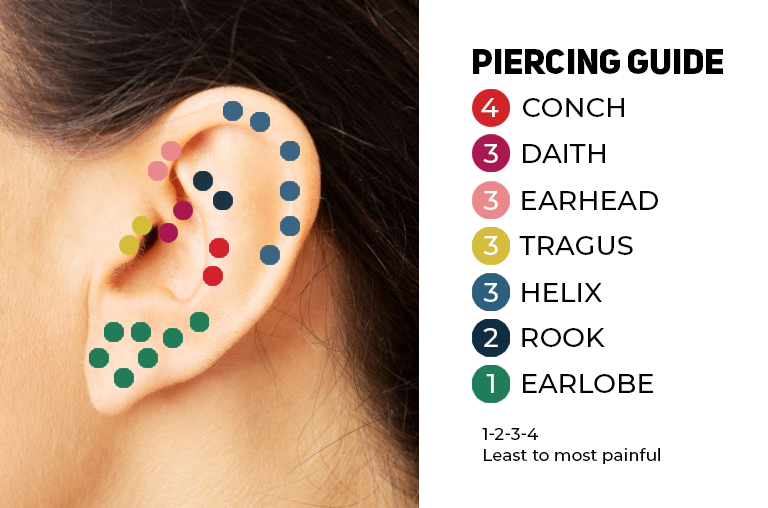Understanding Body Woman Body Piercing Pain Chart: A Comprehensive Guide
Body piercing has become a popular form of self-expression among women, but understanding the associated pain levels is crucial for making informed decisions. The body woman body piercing pain chart serves as a valuable resource for those considering various types of piercings. In this article, we will delve deep into the pain levels associated with different body piercings, providing insights that can help you navigate your body art journey with confidence.
Whether you are contemplating your first piercing or looking to expand your collection, understanding the pain levels can significantly affect your experience. It’s important to remember that pain is subjective, and individual experiences may vary. However, having a reliable pain chart can guide your expectations and help you prepare mentally and physically.
In addition to pain levels, we will explore the healing process, aftercare tips, and potential complications related to body piercings. This comprehensive guide aims to equip you with the necessary knowledge to make informed choices about your body art.
Table of Contents
- What is Body Piercing?
- Body Woman Body Piercing Pain Chart
- Factors Affecting Pain Levels
- Common Types of Body Piercings
- Healing Process for Body Piercings
- Aftercare Tips for Piercings
- Potential Complications of Body Piercings
- Conclusion
What is Body Piercing?
Body piercing is the practice of puncturing or cutting a part of the human body to create an opening for the insertion of jewelry or other decorative items. This form of body modification has a rich history, with roots tracing back to various cultures around the world. Today, body piercing is widely accepted in many societies and is often seen as a form of self-expression.
Body Woman Body Piercing Pain Chart
The body woman body piercing pain chart categorizes pain levels associated with different types of piercings. Below is a general outline of pain levels on a scale of 1 to 10, with 1 being minimal pain and 10 being extreme pain.
| Piercing Type | Pain Level (1-10) |
|---|---|
| Earlobe | 2 |
| Cartilage (upper ear) | 5 |
| Nostril | 4 |
| Septum | 6 |
| Eyebrow | 5 |
| Tongue | 4 |
| Lip | 5 |
| Naval | 4 |
| Nipple | 7 |
| Genital | 8 |
Understanding the Pain Levels
As seen in the chart, pain levels vary significantly across different piercing locations. Here’s a breakdown of some common piercings and their associated pain levels:
- Earlobe: Generally considered one of the least painful piercings.
- Cartilage: Painful due to the density of the cartilage tissue.
- Nipple: Often described as sharp and intense but quick.
- Genital: Known for higher pain levels due to sensitivity.
Factors Affecting Pain Levels
Several factors can influence the pain levels experienced during a body piercing. Understanding these factors can help you prepare adequately:
- Individual Pain Threshold: Everyone has a different tolerance for pain.
- Location of the Piercing: Sensitive areas typically experience more pain.
- Technique of the Piercer: An experienced piercer can minimize pain.
- State of Mind: Anxiety can amplify the perception of pain.
Common Types of Body Piercings
Here are some of the most popular types of body piercings, along with brief descriptions:
- Earlobe Piercing: A classic and widely accepted piercing.
- Cartilage Piercing: Includes various styles such as helix and tragus.
- Nostril Piercing: A common facial piercing that can be styled with various jewelry.
- Tongue Piercing: Known for its quick healing time and unique aesthetic.
- Navel Piercing: Popular among women, often adorned with decorative jewelry.
- Nipple Piercing: More common than many realize, it can be quite painful.
- Genital Piercing: Various styles for both men and women, often considered to enhance pleasure.
Healing Process for Body Piercings
The healing process varies depending on the type of piercing. Here’s a general overview:
- Earlobe: 6-8 weeks
- Cartilage: 3-12 months
- Nostril: 2-4 months
- Tongue: 3-4 weeks
- Navel: 6-12 months
- Nipple: 6-12 months
- Genital: 4-8 weeks
Aftercare Tips for Piercings
Proper aftercare is essential for healing and preventing infections. Here are some key tips:
- Keep the area clean and dry.
- Avoid touching or twisting the jewelry unnecessarily.
- Use saline solution or recommended antiseptics for cleaning.
- Avoid swimming in pools, lakes, or hot tubs during the healing process.
Potential Complications of Body Piercings
While body piercings are generally safe, complications can arise. Be aware of the following:
- Infections: The most common complication, can occur if proper aftercare is not followed.
- Allergic Reactions: Some individuals may react to certain metals.
- Keloids: Raised scars that can form around the piercing site.
- Migration or Rejection: The body may push the jewelry out, especially with surface piercings.
Conclusion
Understanding the body woman body piercing pain chart is essential for anyone considering body art. By being informed about pain levels, healing processes, and aftercare, you can make confident decisions about your piercings. Always consult with a professional piercer and prioritize your health and safety.
We encourage you to share your thoughts in the comments below, and feel free to share this article with friends who might find it helpful. Explore our other articles to learn more about body piercings, aftercare, and more.
Final Thoughts
Body piercing is an exciting journey that allows for personal expression. With the right information and preparation, you can enjoy your piercing experience and embrace your unique style. We hope to see you back soon for more informative articles!
Exploring The Fascinating Animals That Start With The Letter E
Troy Aikman Wife: The Life And Legacy Of A Football Icon
Age Of Big Bang Theory Characters: A Comprehensive Guide


